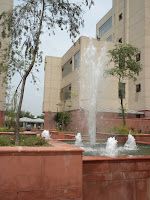I finally have internet access on my laptop and so am able to write about
NALSAR (National Academy of Legal Studies and Research) in Hyderabad, where I was last week. NALSAR graduated its first class in 2003. Some of you know Nawneet Vibhaw, who got his LLM at Lewis & Clark this year. He's a graduate of NALSAR.
First, some photos to give on idea of how beautiful this campus is. On the left is the Guest House, where I stayed (and ate simple but incredibly delicious vegetarian food prepared by Mr. Anan). On the right is the classroom area.


Here's a view of the library . . . .and some students outside the dining hall.


Yes, there's a big dining hall because this is a residential university and all students live on campus. The national law schools in India, such as NALSAR, start law students as undergraduates (and this is true in most countries in the world). After 5 years they get a joint BA and law degree. NALSAR and the other national law schools are not general universities, though: all the students at NALSAR study law, and it takes 5 years to get the first degree. For the first 3 years, all classes are required. There are about 80 students in each year, and they're all together all the time. In fact, they don't move from class to class -- they stay put (in the 1st-year classroom, the 2nd-year classroom, and so on) and the professors come to them. Most classes are also required in the 4th and 5th years, but there are also some electives.
Once in class, though, any U.S.-trained lawyer would feel right at home, largely because India follows the common law tradition (we were both British colonies, after all). I sat in on a 1st-year legal methods class today taught by an excellent professor. She used lecture to set the stage, asked provocative questions, and soon had a really lively and interesting discussion going that involved large numbers of students. The topics being discussed would have been familiar, too -- any one of our students could have joined right in.
NALSAR students don't have the problem of dealing with an entire grade based on one exam at the end of the semester. But I'm not sure that U.S. law students would like their regime any better: compulsory attendance figured into the grade, a 20-page research paper plus class presentation for each and every class (5 classes per semester), a surprise exam around a month in, a mid-term, and a final that covers the whole semester. Lots of ways to compensate for a bad day, though.
Assuming technology continues to be friendly, I'll post a number of things in quick order about the experiences Bob and I have been having.
 The National Law University in Delhi is the last of the national law schools we are visiting and the newest. The physical plant is still being constructed. The campus is beautiful -- these photos give some idea -- and is connected to central Delhi by the new metro.
The National Law University in Delhi is the last of the national law schools we are visiting and the newest. The physical plant is still being constructed. The campus is beautiful -- these photos give some idea -- and is connected to central Delhi by the new metro.






















